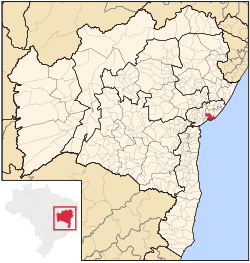Salvador de Bahia
| Salvador | |||
|---|---|---|---|
| Municipality | |||
| Municipal de Salvador Municipality of Salvador |
|||

From the top: Farol da Barra Lighthouse, Ponta de Santo Antonio, southern end of town. Featured, the Barra Lighthouse, Buildings Facades in the Harbor at Salvador, Lacerda Elevator, The monument to the heroes of the battles of Independence of Bahia, panoramic view of the city.
|
|||
|
|||
| Nickname(s): Roma Negra (Black Rome) and Soterópolis | |||
 Location of Salvador in the State of Bahia |
|||
| Location in Brazil | |||
| Coordinates: 12°58′29″S 38°28′36″W / 12.97472°S 38.47667°WCoordinates: 12°58′29″S 38°28′36″W / 12.97472°S 38.47667°W | |||
| Country |
|
||
| Region | Northeast | ||
| State |
|
||
| Founded | 29 March 1549 | ||
| Government | |||
| • Mayor | Antônio Carlos Magalhães Neto (DEM) | ||
| • Deputy Mayor | Bruno Reis (PMDB) | ||
| Area | |||
| • Municipality | 693 km2 (268 sq mi) | ||
| Elevation | 8 m (26 ft) | ||
| Population (2014) | |||
| • Municipality | 2,902,927 (3rd) | ||
| • Density | 4,187/km2 (10,840/sq mi) | ||
| • Metro | 3,919,864 (7th) | ||
| Time zone | UTC-3 | ||
| Postal Code | 40000-000 | ||
| Area code(s) | +55 71 | ||
| Website | www.salvador.ba.gov.br (Portuguese) | ||
| Historic Centre of Salvador de Bahia | |
|---|---|
| Name as inscribed on the World Heritage List | |

Old houses in the historical center of Salvador.
|
|
| Location | Brazil |
| Type | Cultural |
| Criteria | iv, vi |
| Reference | 309 |
| UNESCO region | Latin America and the Caribbean |
| Inscription history | |
| Inscription | 1985 (9th Session) |
Salvador, also known as São Salvador,Salvador de Bahia, and Salvador da Bahia (Brazilian Portuguese: [sawvaˈdoʁ da baˈi.ɐ]), is the capital of the Brazilian state of Bahia. With 2.9 million people (2013), it is the largest city proper in the Northeast Region and the 3rd-largest city proper in the country, after São Paulo and Rio de Janeiro.
Founded by the Portuguese in 1549 as the first capital of Brazil, Salvador is one of the oldest colonial cities in the Americas. A sharp escarpment divides its Lower Town (Cidade Baixa) from its Upper Town (Cidade Alta) by some 85 meters (279 ft). The Elevador Lacerda, Brazil's first elevator, has connected the two since 1873. The Pelourinho district of the upper town, still home to many examples of Portuguese colonial architecture and historical monuments, was named a World Heritage Site by UNESCO in 1985. The city's cathedral is the see of the primate of Brazil and its Carnival celebration has been reckoned as the largest party in the world. Salvador was the first slave port in the Americas and the African influence of the slaves' descendants makes it a center of Afro-Brazilian (preto) culture. The city is noted for its cuisine, music, and architecture. Porto da Barra Beach in Barra has been named one of the best beaches in the world. Itaipava Arena Fonte Nova was the site of the city's games during the 2014 Brazilian World Cup.
...
Wikipedia



